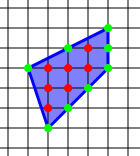Geometry Help
Given a simple polygon constructed on a grid of equal-distanced points (i.e., points with integer coordinates) such that all the polygon's vertices are grid points, Pick's theorem provides a simple formula for calculating the area A of this polygon in terms of the number i of lattice points in the interior located in the polygon and the number b of lattice points on the boundary placed on the polygon's perimeter:

i = 7, b = 8,
A = i + b/2 − 1 = 10
see: https://en.wikipedia.org/wiki/Pick%27s_theorem
1. What is the area of this polygon?

\(\begin{array}{|rcll|} \hline i &=& 33 \\ b &=& 20 \\ A &=& 33 + \frac{20}{2} - 1 \\ A &=& 42\\ \hline \end{array}\)
2. What is the area of this polygon?

\(\begin{array}{|rcll|} \hline i &=& 34 \\ b &=& 21 \\ A &=& 34 + \frac{21}{2} - 1 \\ A &=& 43.5 \\ \hline \end{array}\)
4. This figure is made up of a rectangle and parallelogram.
What is the area of this figure?

\(\begin{array}{|rcll|} \hline i &=& 18 \\ b &=& 18 \\ A &=& 18 + \frac{18}{2} - 1 \\ A &=& 26\\ \hline \end{array}\)
![]()